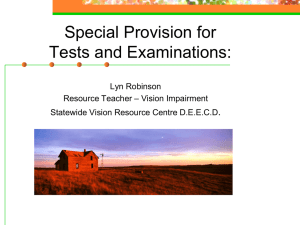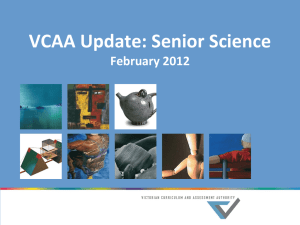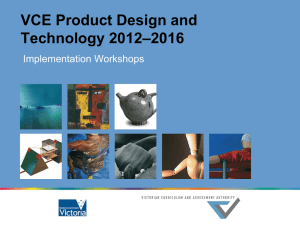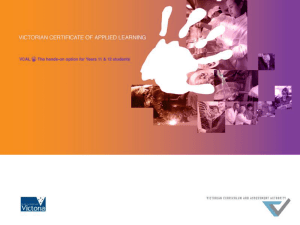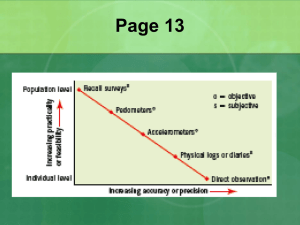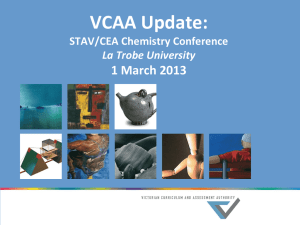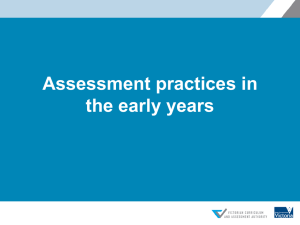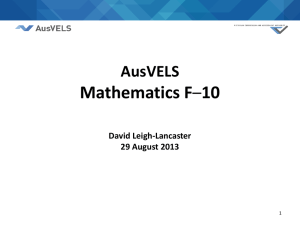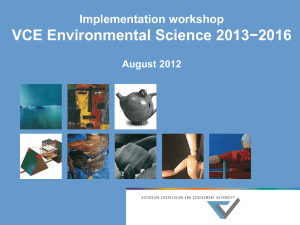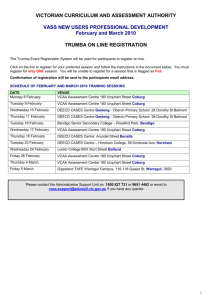Curriculum in Victoria 2013+ - Victorian Curriculum and Assessment
advertisement
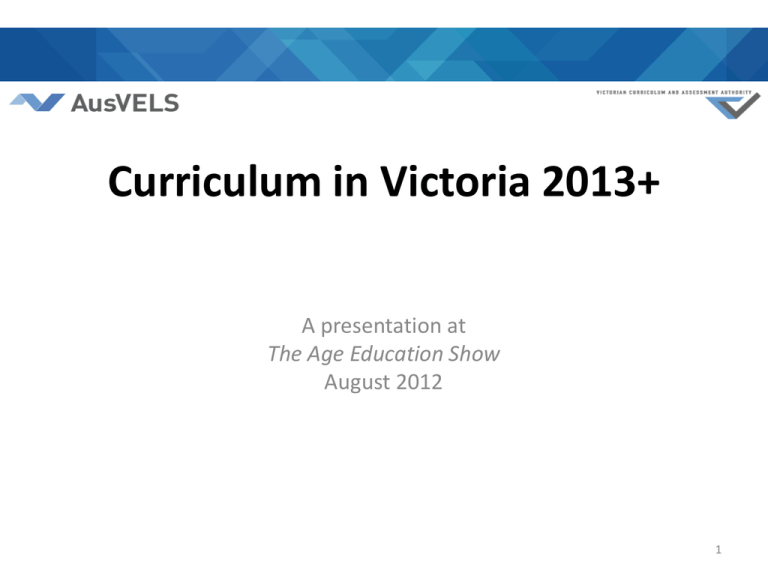
Curriculum in Victoria 2013+ A presentation at The Age Education Show August 2012 1 VCAA Victorian Curriculum and Assessment Authority (VCAA) is responsible for: • developing and publishing the curriculum for Victoria schools F–12 and early childhood services • assessment • National Assessment Program – Literacy and Numeracy Testing in Victoria • On Demand Assessment Program • AusVELS unit responsible for curriculum F–10 2 Early Years at a glance www.vcaa.vic.edu.au/earlyyears • Early Years Exchange – online resource for early childhood professionals • Learning English as an Additional Language in the Early Years (birth to six years) • Assessment for Learning and Development Project 2012 • Professional Learning Resources – flyer 3 What’s happening for F-10? 2012 VELS http://vels.vcaa.vic.edu.au/ 2013+ AusVELS http://www.vcaa.vic.edu.au/foundation10/curriculum /index.html General Information http://www.vcaa.vic.edu.au/foundation10/f10index.html 4 What is the Australian Curriculum? LEARNING AREAS/ SUBJECT DISCIPLINES •English •Mathematics •Science •Health and Physical Education •Languages •Humanities and Social Sciences (History, Geography, Civics and Citizenship, Business and Economics) •The Arts •Technologies (inc. ICT) GENERAL CAPABILITIES CROSS-CURRICULUM PRIORITIES • Critical and creative thinking • Aboriginal and Torres Strait • Personal and social Islander histories and capability cultures • Intercultural understanding • Asia and Australia’s • Ethical behaviour engagement with Asia • Literacy • Sustainability • Numeracy • ICT 5 Victorian timelines Phase 1 English, Mathematics, History and Science • • • Professional development F-10 School-based planning and trialling F-10 Drafting of 11-12 curriculum 2012 • • Implementation of English, Mathematics, History and Science F – 10 “Packaging” of agreed 11-12 curriculum into VCE studies 2013 • Implementation workshops for new study designs in English, Mathematics, History and Science 2014 • New study designs introduced for Units 1 and 2 English, Mathematics, History and Science 2015? • New study designs introduced for Units 3 and 4 English, Mathematics, History and Science 2016? • Accreditation of new study designs 2015-2020 6 AusVELS at a glance • AC English • AC Mathematics • AC History • AC Science Plus remainder of VELS http://ausvels.vcaa.vic.edu.au/ 7 AusVELS consists of 11 Levels from F to 10 Learning Areas (domains) Strands Content descriptions Achievement standards Work samples Cross Curriculum Priorities Nominal school level VELS Level AusVELS Level Prep/Foundation 1 Foundation 1 2 1 2 3 2 3 4 5 4 4 6 7 10 5 6 5 8 9 3 7 8 6 9 10 9 F-10 website 10 Resources to support implementation AusVELS 11 Register for online professional development programs 12 Senior Secondary at a glance - VCE • VCE designed to be completed over 2 years but not restricted • 42 VCE studies plus 46 VCE Languages • combination of school and external assessment (VCAA) • Higher Education Studies (university) can be included • Study designs are published online only from 2012 (hard copies still current) • assessment handbooks 13 Senior Secondary at a glance - VCE • Students are required to satisfactorily complete minimum 16 VCE units, (most students complete 2224) including 3 from the English group • Unit 3 and 4 study scores contribute to ATAR • VCAA Administrative Handbook on website • www.vcaa.vic.edu.au/vce/index.html 14 Senior Secondary at a glance - VET Senior School Certificates VCAL VCE (Victorian Certificate of Education) Usually 20-24 units 90 different studies available (Victorian Certificate of Applied Learning) Literacy & Numeracy, Industry Specific Skills, Work Related Skills, Personal Development Skills Vocational Education & Training VCE VET Program School Based Apprenticeship and Traineeship Other VET Certificates Training (TAFE or school, industry, RTO, ACE) Structured Workplace Learning 15 VET – Key features • nationally recognised training – 350+ qualifications • VCE VET programs, Block Credit Recognition, Apprenticeships and Traineeships • scored assessment in 14 VCE VET programs • multiple and varied delivery mechanisms • you may not teach it but you will teach someone who is doing some VET • http://www.vcaa.vic.edu.au/vet/index.html 16 Senior Secondary at a glance - VCAL • Senior secondary school qualification • in 2011 there were 21,350 enrolments in 440 providers • has a focus on applied learning or hands on learning • develops and extends pathways for young people to: —Work, apprenticeships/traineeships —Training and further education 17 VCAL Resources • professional development program for VCAL providers • Curriculum Planning Guides • Unit Assessment Planning Guide • VCE and VCAL Administrative Handbook • brochures for parents/Year 10 students • Web address: www.vcaa.vic.edu.au 18 Contact Information Early Years Telephone: (03) 9651 4334 Email: veyldf@edumail.vic.gov.au AusVELS Telephone: (03) 9651 4617 Email: vcaa.vels@edumail.vic.gov.au VCE Telephone: (03) 9651 4453 Email: curriculum.vcaa@edumail.vic.gov.au VET Telephone (03) 9651 4458 Email: vet.vcaa@edumail.vic.gov.au VCAL Telephone: (03) 9651 4435 Email: vcaa.vcal@edumail.vic.gov.au 19 F-10 Assessment National Testing • What is NAPLAN? What is tested? How is this reported to parents and to schools? How can teachers make best use of NAPLAN data? On Demand Testing • What types of tests are available on the On Demand system? How can they be used? How are students’ results reported? 20 What is NAPLAN? National Assessment Program – Literacy And Numeracy • The NAPLAN is a series of Literacy and Numeracy tests that are delivered to all Australian Year 3, 5, 7 and 9 students at the same time, every year. 21 Who develops the NAPLAN tests? • The Australian Curriculum, Assessment and Reporting Authority (ACARA) has the responsibility for developing the NAPLAN tests. • Item development and test construction is done in consultation with the VCAA and other state test administration authorities. Who participates in NAPLAN? • Participation in NAPLAN is compulsory for all students in Years 3, 5, 7 and 9 across Australia. • Exemptions can be granted to students with significant intellectual disabilities, or to those who have been learning English for less than one year. • Students with disabilities should be given the opportunity to participate in the tests, rather than being automatically exempted, and a range of disability adjustments are available to assist students. 22 What is tested? Literacy • Reading (questions related to texts in a reading magazine). • Writing (narrative or persuasive writing, based on a common prompt). • Language Conventions (spelling, grammar and punctuation). Numeracy • Includes Number, Algebra, function and pattern (Structure), Space and Measurement, chance and data. • Year 7 and Year 9 students complete two Numeracy tests – one in which the use of a calculator is allowed, and one in which it is not. 23 Reporting NAPLAN results National Report (ACARA) Includes national and state statistics. A preliminary report (September) is followed by a more detailed report in December. Website: www.nap.edu.au Parent Reports Delivered to schools for distribution to parents. Show the student’s achievement in each test area with respect to national average and middle 60% of results. School Reports The web-based NAPLAN Data Service provides school and student data, with comparisons to state and national results. The first release (September) contains school, state and some national level data. A second release occurs when full national data are supplied to the VCAA. Website: https://naplands.vcaa.vic.edu.au The MySchool website Developed by the Australian Curriculum, Assessment and Reporting Authority (ACARA). Provides school level data on Australian schools, with reference to national results and results from statistically similar schools. Website: http://www.myschool.edu.au/ 24 The NAPLAN Data Service The NAPLAN Data Service contains a number of reports that provide summary and diagnostic information about student performance at school and classroom levels. 2012 Reports available: •School Summary Report •Group Summary Report •Assessment Area Report •Writing Criteria Report •Item Analysis Report •Student Response Report •Student Achievement Level Report •Five Year Trend Report •School Comparison Report •Student Comparison Report •Relative Growth Report* *this is a new report for 2012, and replaces the Student Comparison Report (2009 – 2011) 25 On Demand Tests and Reports • The VCAA Assessment Online (On Demand) System delivers online tests from a central repository to students’ computers via the Internet and a school’s local network. • Contains Adaptive and Linear tests in English and Mathematics, at both dimension and domain levels. • Teachers use the resource when, where and how they choose, and the tests are automatically marked. • At classroom level, the system can be used to: – establish the general VELS range at which students are performing (adaptive tests). – identify individual strengths and weaknesses (progress tests). – corroborate teacher judgements. – assist in planning of teaching programs. – monitor student progress; pre and post testing. 26 On Demand Information and Support VCAA On Demand documentation http://www.vcaa.vic.edu.au/prep10/ondemand/index.html On Demand Helpdesk Freecall: 1800 827 721 Email: vcaa.ondemand.support@edumail.vic.gov.au 27
